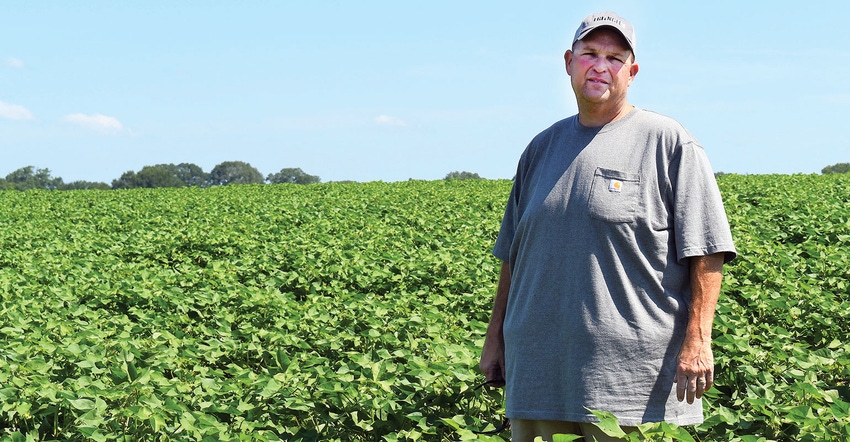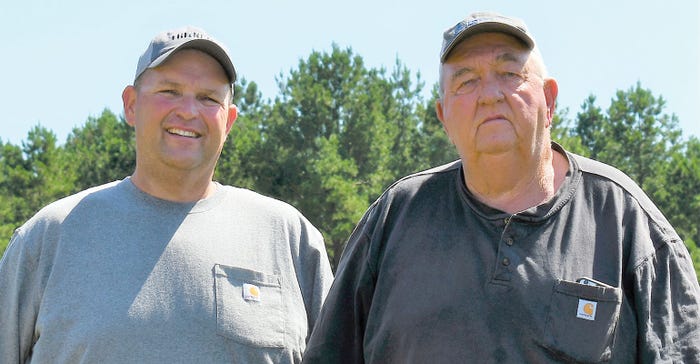
Walter Oliver is a cotton farmer and says technology and a sound rotation play important roles in maintaining an efficient operation. Keeping acreage close is also an advantage.
“I would rather farm cotton than anything else, and my preferred rotation is a cotton and corn rotation. We produce good corn on our land, and then the next year the cotton we plant behind the corn is always the best we have. We have also raised peanuts in the past,” he said. “Unfortunately, the market is not too good on cotton right now. Last year around June, it was pushing 90 cents, and now it’s down 30 percent in as little as a year.”
Oliver has been farming ever since he graduated from Mississippi State University in 1995, but Oliver Farms was established long before.
“We have been farming on the same land since 1914,” said Oliver. “It’s just what my family does. I started farming with my father, Bobby Oliver, until he retired in 2009. Since then, I farm it all myself with the help of three full-time workers and my two boys.”
Oliver farms 3,800 acres in Montgomery and Carroll counties in Mississippi, 1,500 of which he owns and the rest is rented.
He said that one of the most time-consuming aspects of farming in the hills is moving equipment. That is why he likes to stay close and keep his land close at hand from one field to another.
“I’d rather stay close. It makes it so much easier to get more done with all the equipment being closer. In the hills, there are mostly small fields, which means a lot of moving back and forth. We make it work by keeping our fields as close as possible from one another,” he said.

Technology
Thanks to the new technology in cotton, planting cotton has become easier to raise more acres with less equipment.
“This year was the first year we planted the 2,4-D cotton that you can spray with Enlist because we were having trouble with pigweeds, and all the new technology is amazing,” said Oliver.
Oliver Farms uses GPS technology, swath control on the sprayers, planters, and fertilizers to save inputs.
“GPS is a wonderful piece of technology for farming,” he said. “Also, the WideStrike 3 cotton that we planted has been a great addition this year which consist of all PhytoGen, so we can spray Enlist over it. We were getting resistant pigweeds, and it has been nice to be able to spray them with the 2,4-D over the cotton.”
Non-irrigated
“We’re 100 percent non-irrigated,” said Oliver. “Some people would say that is a problem farming in the hills, but we’ve always done fine without it. Some years, I wish we could irrigate, but this year, we’re fighting the fact that it’s too wet. We’ve had some flooding in areas, but most of what we’re dealing with is the ground is too saturated. It just will not dry up.”
Because of the wet conditions, Oliver, like many farmers this season, could not plant until late.
“We were late planting the cotton. We didn’t get all the corn planted that we originally intended. Instead, we planted about 250 acres and planted more cotton to make up for the corn,” he said.
At the time of planting, corn was $3.50 a bushel, so cotton was a better choice as far as the prices were concerned.
“I would like to be on a fifty-fifty corn and cotton rotation, but corn had been down in the past few years. Corn has since gone up, so it would have been better to have more corn,” he said. “Hindsight is always twenty-twenty.”
Weed/pest control
Oliver said that the ideal planting window for cotton in the area is usually around the first of May and for corn, April 1-10.
“This year, we didn’t get to plant until the end of the usual months we plant instead of the beginning,” he said.
The main weed control problem for his farm is resistant pigweeds.
“I plant as much no-till as possible, so instead, we will do a control burn. This year we’re close to 100 percent no-till,” Oliver said. “We have some new farm land that we had to do tillage on to get on our row pattern, but other than that, we’re all no-till. We just burned down with Roundup Valor and 2,4-D or dicamba. Next, we plant and spray Roundup behind the planter, and then I come back with Roundup, Enlist, and Dual. After that, we only spray as needed.”
The major pest on the farm is deer.
“The deer pressure this year has been worse than ever. Every farmer I’ve talked to has had problems with deer this year,” he said. “We’ve had hogs in the area in the past, but we haven’t really had any hog problems this year. The deer have been terrible, though.”
While Oliver has taken measures to prevent deer, including sprays to deter them, he says at the end of the day, it is something you must live with as a farmer.
Peanut farming
Oliver has gotten away from peanuts because of harvest timing and soil type. “I haven’t planted peanuts in the past two years. It’s a slow harvest and our soil is not quite sandy enough. We had some trouble digging last time, but we can plant them in selective ground. I may plant some next year since I still have all the equipment.”
It is largely because of the support of Oliver’s family that he can do all that he does. He and his wife Christie have three children: a daughter, Lucy, and two sons, Rhett and Reese.
“We just do the best we can on our farm,” he said.
About the Author(s)
You May Also Like




